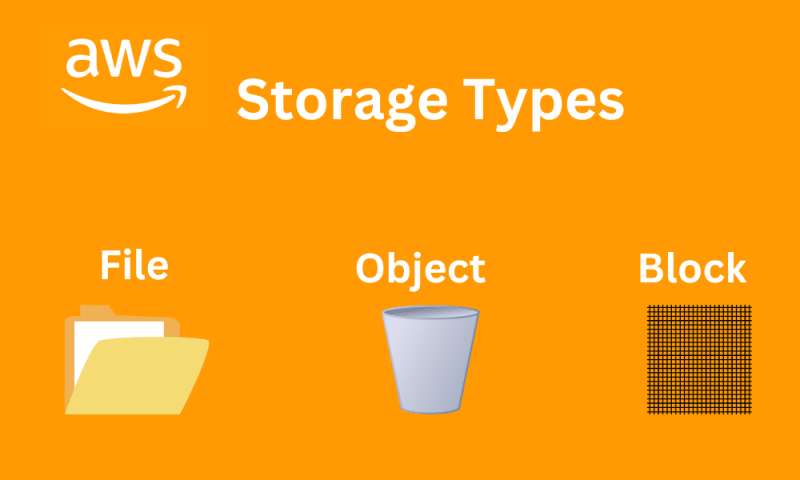In today's digital age, data is the lifeblood of businesses and organizations. Storing, managing, and accessing data efficiently is crucial for success. Amazon Web Services (AWS)is one of the top cloud providers offers a range of storage services to cater to various workloads and use cases.
In this blog post, we'll explore AWS's core storage services: Block Storage, File Storage, and Object Storage.
Block Storage
Block storage is akin to having dedicated, low-latency storage for each host, making it ideal for high-performance workloads such as databases and ERP systems. Amazon Elastic Block Store (Amazon EBS) is the go-to solution for attaching storage to Amazon Elastic Compute Cloud (Amazon EC2) instances. It offers different options to meet specific use case requirements, from SSD-backed volumes for high I/O performance to HDD-backed volumes for cost-effective storage.
Block storage is a type of storage that divides data into fixed-sized blocks or chunks, typically ranging from a few kilobytes to several megabytes in size. These blocks are then stored on a storage device, such as a hard disk drive (HDD) or a solid-state drive (SSD). Block storage devices are usually associated with specific servers or virtual machines and provide a way to manage data at a lower level compared to file or object storage.
Here are some key characteristics and use cases of block storage:
1. Low-Level Data Storage:
Block storage operates at a lower level than file or object storage, dealing with individual blocks of data. This makes it highly efficient for certain types of workloads, such as databases, because it allows for precise control over data placement and access.
2. Performance and Low Latency:
Block storage is known for its low latency and high I/O (input/output) performance. This makes it suitable for applications that require fast and predictable data access, such as databases, virtual machines, and high-performance computing (HPC) clusters.
3. Direct Attached Storage (DAS):
In on-premises environments, block storage is often used as direct-attached storage (DAS), where the storage device is physically connected to a single server or host. This configuration offers dedicated and exclusive access to the storage.
4. Storage Area Network (SAN):
In cloud and enterprise environments, block storage can also be used in Storage Area Networks (SANs). SANs provide shared storage that multiple servers or virtual machines can access simultaneously. AWS's block storage service, Amazon Elastic Block Store (Amazon EBS), is a cloud-based example of block storage designed to work with Amazon EC2 instances.
5. Data Persistence:
Data stored in block storage persists independently of the virtual machine or server. This means that data remains intact even if the associated compute instance is terminated, making it suitable for storing critical data that must survive instance failures.
6. Snapshot and Backup:
Block storage often provides features like snapshots and backups, which allow you to create point-in-time copies of your data for data protection and recovery purposes. In AWS, Amazon EBS offers snapshot capabilities.
7. Use Cases:
Block storage is ideal for use cases where precise control over data, low latency, and high performance are essential. Common use cases include hosting databases (relational or NoSQL), running enterprise applications, maintaining boot volumes for virtual machines, and supporting mission-critical workloads.
In AWS, Amazon EBS is the primary block storage service. It offers various volume types, including General Purpose (SSD), Provisioned IOPS (SSD), and Magnetic (HDD), each optimized for different workloads. Amazon EBS volumes can be attached to Amazon EC2 instances, providing scalable and reliable block storage for your cloud-based applications.
When using Amazon EBS, you can also leverage features such as data snapshots, which allow you to create point-in-time copies of your volumes, and Elastic Volumes, which enable you to dynamically adjust volume size and performance to meet changing storage needs.
File Storage
Some applications require shared access to files, similar to Network Attached Storage (NAS). AWS provides multiple file storage options, including Amazon Elastic File System (Amazon EFS), Amazon FSx for Lustre, Amazon FSx for Windows File Server, Amazon FSx for NetApp ONTAP, and Amazon FSx for OpenZFS.
Amazon EFS is a multi-Availability Zone file storage service using the NFS protocol.
Amazon FSx for Lustre is built for high-performance computing (HPC) and machine learning workloads.
Amazon FSx for Windows File Server is tailored for Microsoft applications with the SMB protocol.
Amazon FSx for NetApp ONTAP offers both block and file storage with iSCSI, NFS, and SMB protocols.
Amazon FSx for OpenZFS is a fully managed shared file storage service based on the OpenZFS file system.
Each service offers unique feature sets to suit your requirements, whether you need scalability, high performance, or compatibility with specific protocols.
Object Storage
Object storage is designed for scalability, metadata-rich characteristics, and is perfect for modern cloud-native applications. Amazon Simple Storage Service (Amazon S3) is AWS's object storage offering, available in various storage classes to match price, access, and availability needs. For archival storage at a lower cost, Amazon S3 Glacier is a popular choice.
In addition to serving as a standalone object storage service, Amazon S3 is used for storing snapshots and backups of data from other core storage services like Amazon EBS and Amazon EFS. Its versatility makes it a cornerstone of AWS storage solutions.
Conclusion
AWS provides a comprehensive suite of storage services to accommodate diverse workloads and use cases. Understanding the differences and capabilities of block, file, and object storage is crucial for making informed decisions when architecting your AWS infrastructure.
Whether you're running performance-intensive databases, need shared file access for development environments, or are building scalable cloud-native applications, AWS has the right storage solution for you.
By leveraging these storage services effectively, you can ensure data availability, scalability, and cost-effectiveness for your organization's unique needs in the cloud. Choose wisely, and your AWS storage infrastructure will be the backbone of your successful cloud journey.








Top comments (0)